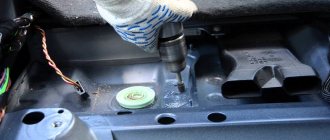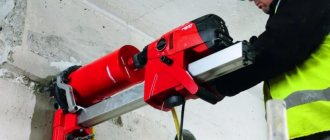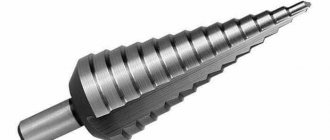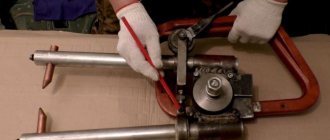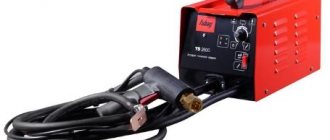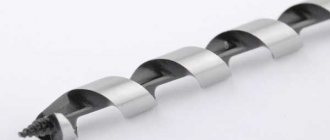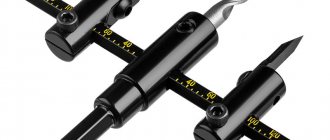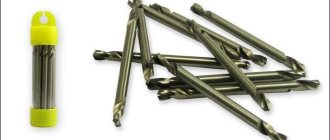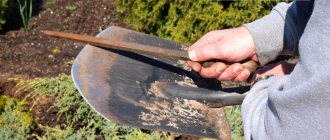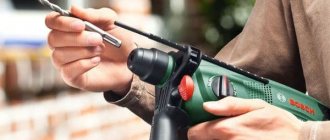Drill bit for drilling spot welding - design, sharpening
Reading time: 3 minutes
Spot (aka contact) welding is one of the simplest, and at the same time frequently used technologies for joining metals and polymers. This is a quick method that allows you to get a permanent connection.
But what if you need to disassemble a resistance welded structure? How to remove weld spots? Professionals often use a drill bit to drill out DIY spot welds. And often such work has to be performed in a car service center. After all, many cars are assembled using the contact method.
Ruman › Blog › How to drill spot welding correctly. Tools and accessories
Novice bodybuilders often wonder how to properly remove a part (fender, sill) when replacing it, if this element is not attached with bolts or screws, but with factory spot welding. Here you need to immediately decide why it is needed. If you take it off and throw it away, then you don’t need to think long, but just use an angle grinder or a chisel and chop as you want, but not everywhere...
In places where the repair part is placed under the metal, for example, the threshold slides under the middle pillar and under the wings at the front and rear, this is where you need to carefully drill out the spots for spot welding.
Not knowing about the existence of special devices, I sharpened simple drills evenly so that they cut the metal around the welding point from resistance welding, oh, I had a lot of trouble with them, I’ll tell you. But let’s not talk about sad things, but let’s move on to the procedure of removing the threshold (for replacement) using special drills for drilling out spot welding.
Design
It is quite easy to recognize a drill for spot welding by its appearance - along its axis there is a core protrusion sharpened to a 90-degree cone, which significantly simplifies the process of centering the drill. The working end is made flat. Based on this, many craftsmen often use ordinary drills with special sharpening to drill holes.
However, another method of drilling out spot welds is possible using special crowns. For this purpose, a tool is used that consists of a spring-loaded centering rod, on top of which a cutting disk with teeth on the end side is placed. During the work process, the master must initially press the core into the metal surface, after which, as the crown is lowered into the thickness of the material, the weld area is drilled. For greater rigidity, the instrument is equipped with a special frame .
It is worth making a comparative assessment of the effectiveness of the presented methods for drilling spot welding, assuming that the material of drills with crowns will be identical, namely P18 high-speed steel. However, nothing excludes the possibility of using other steels, for example, R9K6, R6M5K5 or R6M5. It is best to use domestically made tools. Instead of the usual high-speed cutter, Chinese analogues can use another material, for example, 45X steel, the service life of which is significantly lower!
Drills for this type of welding
Spot welding drills are quite easy to identify by their appearance. Its working end has a flat surface, the axis has a cone-shaped core protrusion at a right angle. With its help, the centering of the drill is removed, which is the most labor-intensive stage in extracting the result of the point procedure.
Due to possible difficulties, experts prefer to use a regular drill, which must be sharpened properly.
An alternative option for drilling welding points is the use of specialized crowns. Their structure includes a rod with springy and centering properties, to which a disk with a cutting surface and several end teeth are attached.
Initially, the master must press the core protrusion into the metal surface, after which, controlling the immersion of the crown into the structure itself, the material is drilled near the welding seam.
To ensure that the part is sufficiently rigid, the structure is enclosed in a frame. In comparison with methods for eliminating the welding in question using a rod, it is worth noting that the material of the part and the crown itself may be the same.
The only difference is the type of steel R6M5, R6M5K5 or R9K6. Often such an item is used in domestic production for car repairs. In the Chinese industry, they prefer high-speed cutting materials from types 45X.
Sharpening a drill for a spot procedure
Any spot welding drill bit has a primary purpose, but it also requires regular sharpening of the part. Items that are used to sharpen drills also need to be cleaned regularly.
Before sharpening a drill for resistance welding, you need to start the process with preparation - blunting. In this procedure, it is best to use regular sandpaper with a hard surface.
Then you need to use it to walk along the side edges. It is worth paying attention that the cutting edge must not be touched. Instead of paper, a special stone is sometimes used. The edges are also processed with it to trim the edges to a high-quality and even level.
Finally, the rod is sharpened to the middle length. The main thing is that drilling is convenient and easy, and for this you need to control the alignment.
Drill
The tool for such purposes consists of three sections:
- Core (its height is chosen so that it is no less than the thickness of the metal of the part, usually 2...3 mm is enough).
- Main cutting part. It can be conventional or coated with titanium nitride, in which case the durability of the drill increases noticeably, and the dimensions of the cutting part will not depend on the heating temperature.
- Mounting part for an electric drill chuck.
The drilling technology in this case is somewhat simplified: first, the core is embedded into the metal of the product, and then the required operation is performed with the side edges of the drill. In this case, the main problem is the need to keep the tool strictly perpendicular to the surface of the body part.
When choosing a drill for spot welding, you must first evaluate the accuracy of the core location, for which a caliper with a vernier division value of 0.01 mm rather than 0.1 mm is suitable. Misalignment leads to the fact that part of the drill works on unhardened metal, and therefore the load on the tool is distributed unevenly. You will also have to spend more time periodically sharpening the drill and the core itself, carefully maintaining its apex angle and height.
Read also: DIY compressor dehumidifier
Using a drill for drilling spot welding, you will also need to change the speed of the drill: at first it should be small, up to 700...800 min -1. However, the total complexity of the operation is still less than in the previous version, and for drilling it is enough to use only one power tool - a drill.
Advantages of a drill for drilling spot welding
The tool in question, which is designed to work with seams, has a fairly large number of advantages. These include:
- The processing procedure is simplified.
- Long-term drilling can be carried out.
- The tool is ideal for creating flat surfaces.
Drilling Spot Welding
As previously noted, you should only purchase products from well-known manufacturers. This is due to the fact that alloyed alloys are characterized by a lower degree of resistance to high temperatures.
How to prepare an area for drilling
When considering such a technology, it is worth considering that the final result largely depends on the quality of surface preparation. The features of this technology include the following points:
- It is recommended to core the drilling site. You can use a screwdriver for this.
- By cleaning the surface of various contaminants, you can significantly improve the quality of the work performed.
If preliminary preparation of the surface is not carried out, then there is a possibility of the rod popping out. If the load angle changes, the rod may break. In addition, with a fairly large contact area, the tool used can overheat greatly.
That is why it is possible to supply liquid to the cutting zone to cool the tool and the processed liquid.
Peculiarities
A spot welding drill bit is used to remove a permanent weld joint. Such a cutter allows you to accurately drill out the welding point without causing significant damage to the surface of the part. Often a tool with a diameter of 8 mm is used for drilling. You can find a similar drilling tool in specialized retail outlets, but its cost can be quite high. However, the purchased drill will recoup your costs by greatly facilitating the procedure for removing parts connected by spot welding.
In addition, a durable steel cutter can be sharpened - the tool can withstand several sharpening cycles and retain its original properties.
The main advantages of the cutter for removing spot welding fasteners.
- It is possible to carry out work on drilling welding without first forming a recess at the welding point, that is, without punching. This feature of the drill is convenient, as it saves a lot of time and effort.
- You can work with a drill for a long time, sequentially drilling several welding points in a row. Even when heated, the drill does not lose its properties.
- The service life of the tool is quite long, since this product is made from high-strength steel grades and has the ability to undergo multiple sharpening cycles.
- After drilling out the weld points, the dismantled part remains preserved for reuse. In addition, the surface of the second workpiece, to which the dismantled part was attached, is not damaged, and it can again be used for its intended purpose.
The tool intended for dismantling welding points is made of alloy steel with the addition of titanium coating . available : with one working side or double-sided . The drill diameters are different - they can be 6, 8 and 10 mm. The choice of drill diameter depends on the size of the weld point that will have to be drilled. In this case, an additional 1.5 mm is added to the diameter of the drilled object.
Design
A drill for spot welding is easy to identify - its working end is flat, and along the axis there is a core projection sharpened to a 90º cone, thanks to which you can get rid of the most labor-intensive stage - centering the drill. Therefore, craftsmen often use ordinary drills sharpened in a special way for drilling.
In principle, another option for drilling spot welding is possible - the use of special crowns. Such a tool includes a centering spring-loaded rod on which a cutting disk with several end teeth is mounted. It is assumed that the user first presses the core into the metal, and then, as the bit sinks into its thickness, drills the metal around the weld area. To give the tool the necessary rigidity, the entire structure is enclosed in a mandrel.
Let us perform a comparative assessment of the effectiveness of both drilling methods, assuming that the metal of the crown and drill is the same: high-speed steel R18 (although tools of this kind are also made from steels R6M5, R6M5K5 and even R9K6). It is preferable to use a domestically produced tool: instead of a high-speed cutter, Chinese manufacturers can offer completely different steel, such as 45X, with an expectedly poor finish.
Crown
The tool itself is quite massive, so initially you need to press the centering rod well against the surface of the metal, and then proceed to cutting out the metal at low speed. The problem lies in the fact that low-carbon steel, which is what all body elements are made of today, is significantly strengthened during spot welding, which is why a lot of effort is required from the worker to press the centering rod into the metal surface.
Another nuance during work is that the teeth of the bit do not cut evenly into the metal, since the steel at the welding site is always distinguished by the presence of microroughnesses formed due to thermal effects from the operation of the electrodes. As a result, there is a high probability of eccentricity of the new hole.
Experienced craftsmen recommend core drilling the drilling area in advance, for example, with a screwdriver, since it often happens that the centering rod unexpectedly slips out of the socket, as a result of which the crown begins to cut metal in the wrong place. With this approach, the worker needs to acquire a pair of power tools.
The problems do not end there - rapid overheating of the bits also negatively affects the work, because the thermal expansion of the bit causes the new hole in the body to become larger than necessary, and the attachment itself begins to crack.
Do not forget to thoroughly clean the crowns from chips after work!
Although not everything is so sad, because modern crowns are double-sided, so after one side has dulled, you can simply turn the tool around and continue cutting metal with the same set.
>
Sharpening a drill bit for spot welding
During the resistance welding process, the metal becomes compacted, making it quite difficult to drill out. Drills must be made of durable high-speed steel and have a special sharpening.
For through drilling. If you plan to scroll through the parts, you can use a regular drill sharpened to a cone. The diameter is selected 1-2 mm wider than the weld point.
For drilling one piece. They have an almost flat sharpening; in the center of the drill there is a protrusion - a leader. It is intended for centering and in appearance resembles a small drill. The leash can be narrow - suitable for working with thin sheet metal, and wide - suitable for working with thick metal. The diameter is selected according to the diameter of the point or slightly wider.
general information
Drills for resistance welding differ from conventional construction drills. They have a special shape, thanks to which they can be used to drill out weld spots obtained by resistance welding. This type of drill can be used with most types of thin sheet metal: from copper to zinc. Products made of polymers can also be drilled.
As we indicated above, a drill for spot welding has a special shape, different from the usual drill. The spot welding drill has a flat end and a small cone-shaped protrusion. The protrusion is sharpened at an angle of 90 degrees and allows you to quickly center the drill relative to the weld point.
Professionals say that it is not necessary to use special drills for spot welding to drill out weld spots. Masters of their craft can sharpen their own drill bit for drilling spot welding, using a regular construction drill bit as a “base”. It really is possible. But sharpening a drill is a topic for a separate article. Because the process is very labor-intensive and requires experience. If you are interested in this topic, watch the video below.
Sheet element processing technology
It is recommended to use drills for drilling resistance spot welding on thin sheet steel only of the type recommended by the manufacturer for working on metal.
Pneumatic drills or electric drills are suitable for these purposes. Each tool has its own pros and cons when working.
An electric tool, if drilled for a long time, becomes very hot. It also cannot be used in damp areas or in rainy weather. The pneumatic type drill is safe to use in the rain or in damp areas.
To drill spot welding joints, you can use drills of a suitable diameter or specialized crowns. The last type of metalworking tool has a design function of limiting the depth of metal cutting.
This is very convenient for long periods of work. The use of a crown will help reduce the numerical percentage of defects when separating parts.
